Sketchbook pages can be a wild adventure! Imagine filling them with nature sketches—bugs, leaves, and even coffee stains for cool effects. Urban scenes, travel moments, mixed media collages, and dreamy watercolor moods all bring your ideas to life. Try adding personal goals, doodled quotes, or fun patterns. Scrapbook with tickets or magazine bits for extra flair, play with emotions in your art, and use bold colors to tell stories. There’s so much more creativity waiting just ahead!
Key Takeaways
- Nature-inspired pages featuring plants, bugs, or wildflowers let you experiment with plein air sketching, plant dyes, and found object collage.
- Travel memory spreads combine on-location sketches, ticket stubs, and handwritten reflections to capture unforgettable journeys.
- Mixed media collage pages blend scraps, paint splatters, and textured layers for playful, experimental artwork.
- Visual storytelling layouts pair expressive characters and journaling to create emotional narratives and creative comic strips.
- Vision board pages use doodles, inspirational quotes, and magazine cutouts to visualize future goals and dreams.
Nature-Inspired Sketches
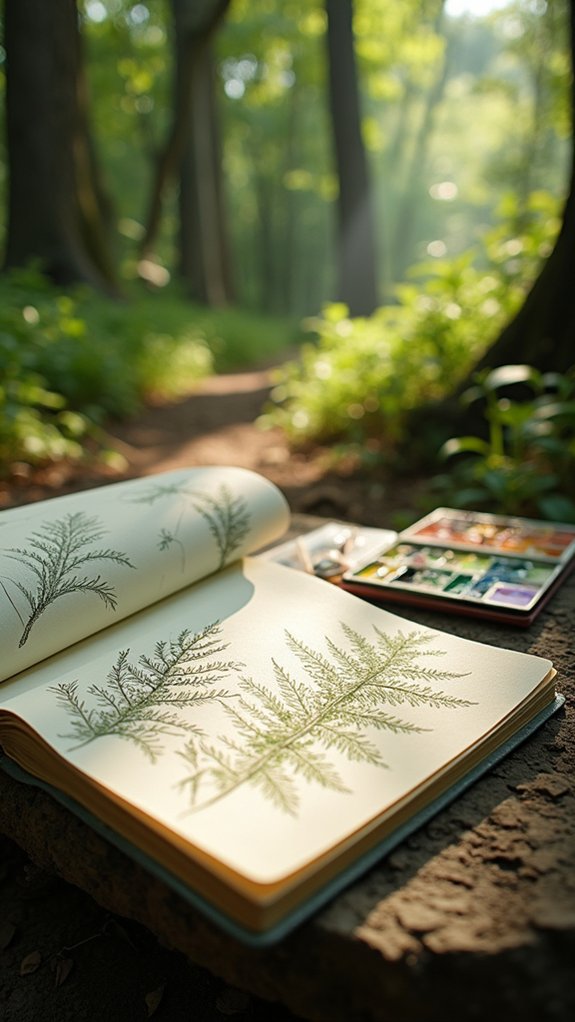
Even if someone thinks they can’t draw a straight line, they can still find magic sketching scenes from nature. A stick, a bug, the twist of a wildflower’s stem—these nature-inspired moments don’t care if a leaf’s edge gets a little wobbly.
On sketchbook pages, everything is fair game. Artists fill them with glimpses of personal feelings, like the peace of a quiet hiking trail or the shock of seeing a bright bird suddenly land nearby.
Plein air drawing, which means drawing outdoors, actually makes it easier to capture the changing light and flutter of leaves. Some adventurous souls even use plant dyes or a splash of brewed coffee, adding cool textures and earthy colors to their work—so mistakes start looking like happy accidents.
Travel Memories and Urban Sketching
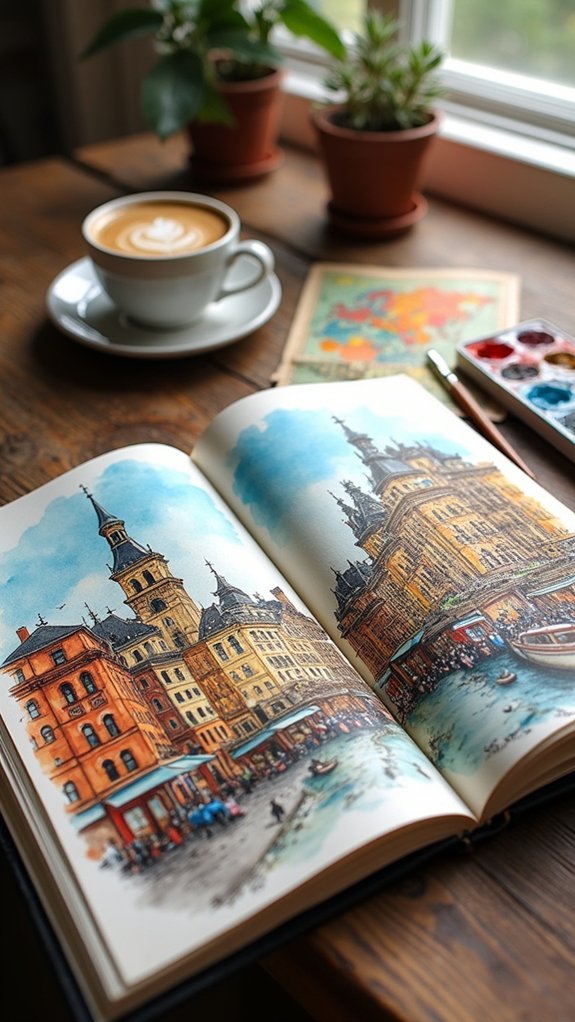
A sketchbook can become a travel buddy, collecting snapshots no camera could ever catch. Travel memories fill its pages, each one brimming with stories from new places.
Urban sketching brings city scenes alive—even a crowded market or a sleepy train station looks amazing. Using mixed media, like layering sketches with ticket stubs or personal notes, artists make every page feel personal and alive.
Trying brewed coffee or juicy watercolors creates unique textures, giving the art a real flavor of the place. There’s something special about sketching on-location; you capture the mood and fleeting moments that tug at your heart later.
To really feel the magic:
- Glue in a ticket stub from that surprising bus ride.
- Splash watercolor raindrops on a city skyline.
- Add your goofy map doodle.
Mixed Media Collage Experiments
There’s nothing quite like diving headfirst into a mixed media collage experiment—one minute you’re gluing in scraps from yesterday’s lunch, the next you’re splattering coffee like some mad art scientist.
Collaged elements like old tickets, magazine clippings, and even random stickers can make each sketchbook page feel like a brand-new adventure. By layering newspaper scraps, transparent papers, and textured bits, artists create pages that are lively, detailed, and full of surprises.
Throw in a dab of paint, a swoop of marker, or the odd pastel swipe, and suddenly the whole thing pops with personal expression.
Every mixed media experiment is a chance to take risks, learn, and grow—because there’s no right or wrong, only more room for artistic growth and wild creativity.
Watercolor Mood Pages

Here’s how watercolor mood pages bring art and emotions together:
- Show feelings without words
- Play with brush techniques for texture
- Add personal expression through materials
Personal Goals and Vision Boards
Ever wonder what it would look like if dreams and doodles teamed up? That’s exactly what happens when sketchbook pages become spaces for personal goals and vision boards!
Using faux calligraphy, creative imagery, or stickers (yes, even those sparkly ones), anyone can map out their hopes and plans in a totally inspiring way. Imagine flipping open your sketchbook and seeing a mashup of lists, magazine cutouts, and your favorite motivational quotes.
It’s more than just eye candy—it keeps you pumped and ready to tackle your goals. Want some bonus points? Revisit and tweak your vision board as you go, reflecting on victories and adjusting future dreams.
Your sketchbook becomes a steady cheerleader, rooting for growth and creativity all year round!
Portrait Studies and Self-Portraits
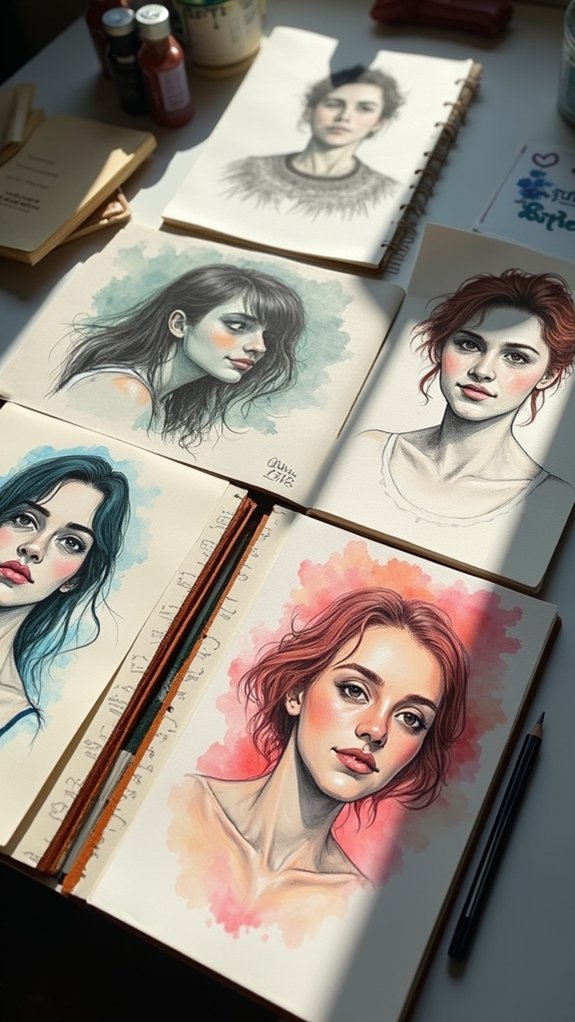
While some sketchbook pages are all about wild patterns or daydream doodles, portrait studies and self-portraits invite artists to slow down and really look.
These pages aren’t just about making something pretty—they’re about noticing every curve, shadow, and quirk of a face. Portrait studies challenge artists to get the hang of human anatomy while improving observation skills.
Self-portraits push things even further, helping artists explore their own feelings and style through artistic expression. Different tools, like pencils, charcoal, or wild splashes of watercolor, can completely change the vibe of each portrait.
Trying new faces, angles, or lighting brings excitement and growth.
- Capture an honest emotion and freeze it forever.
- Discover hidden details in your own reflection.
- Feel that thrill when a face comes alive on paper!
Found Object and Texture Pages
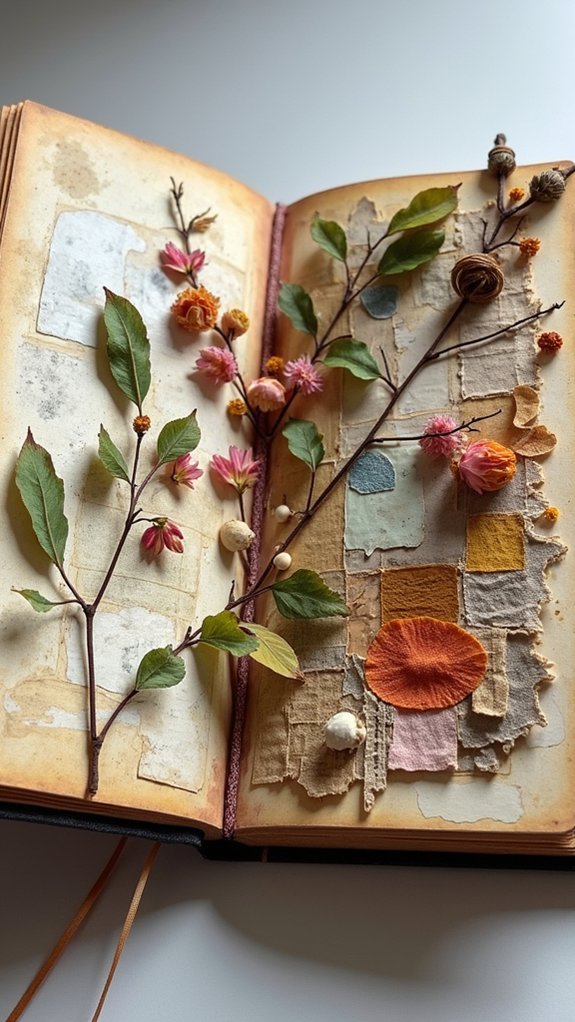
Found Object and Texture Pages are where a sketchbook can get a little wild, with bits of everyday life—movie tickets, leaves, or even candy wrappers—jumping onto the page and making things interesting.
By layering fabric scraps, textured paper, or oddball 3D items (looking at you, lonely button), artists can build pages that people want to touch as much as look at.
Mixing in collage techniques, like gluing down photos or splashing on coffee stains, turns ordinary stuff into a story that pops right off the page—sometimes literally!
Incorporating Everyday Ephemera
Take a look around—sometimes the best sketchbook ideas are hiding in plain sight, just waiting to be scooped up from everyday life.
Adding ephemera like ticket stubs, postcards, or newspaper clippings gives pages rich textures and that cool mixed media look. It’s like telling your story with scraps and scribbles.
Found treasures—maybe a bizarrely shaped leaf or a piece of patterned fabric—make a piece unique and spark creativity. Techniques like decoupage help mix these objects right into your sketches.
Even a splash of brewed coffee can add earthy colors that play well with all those different textures.
Here are three ways this approach can turn a regular page into something unforgettable:
- Remembering a special moment
- Creating playful, surprising textures
- Expressing creativity with every layer
Creating Tactile Layers
Ever stare at a sketchbook page and wish it could do more than just look cool? Adding a tactile twist makes pages come alive!
Imagine pressing a real leaf onto the paper or sticking on ticket stubs, fabric scraps, or buttons. These found objects instantly create fresh textures and tell stories your pencil alone can’t.
Layering different materials—like newspaper clippings, washi tape, or textured paper—lets you build up the page, giving mixed media vibes and tons of personality.
Curious about backgrounds? Try rubbing sandpaper, swiping bubble wrap in paint, or even brushing on brewed coffee for a surprise color wash.
Experimenting with layering and tactile surfaces makes every page unique. It’s like your art is practically begging to be touched—go on, try it!
Mixed Media Collage Exploration
What happens when a sketchbook page turns into a kind of treasure hunt, gathering random bits and pieces to make something incredible?
Mixed media collage exploration transforms ordinary pages into daring experiments using textures, layering, and all sorts of found objects. Imagine ticket stubs from a favorite concert, tiny fabric scraps, or even a leaf from your backyard glued down with care.
Add vintage imagery—maybe an old postcard or a newspaper clipping—and suddenly, your page bursts with stories and history. Every layer, from brewed coffee stains to flecks of gold paint, pulls you into an adventure.
The result? A collage that’s unique and full of surprises!
- Relive unforgettable memories in every layer.
- Feel the excitement of combining old and new.
- Get swept away in a whirlwind of creativity!
Storytelling Through Sequential Art
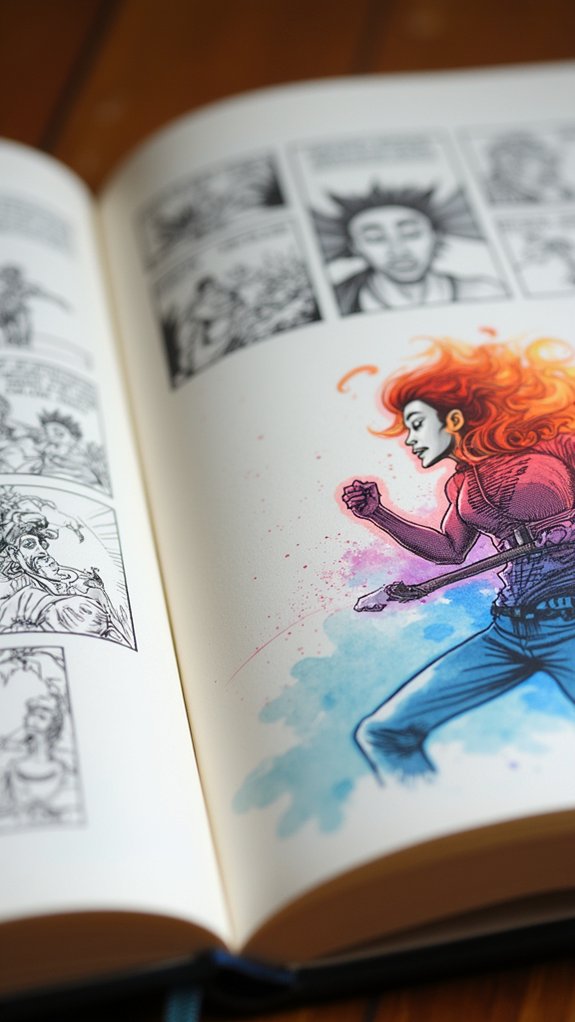
Storytelling in sketchbook pages lets artists use pictures in a row—almost like making their own mini comic book—to craft visual narratives.
Planning out storyboard sequences can feel a little like setting up scenes in a movie, while showing how emotions change from one panel to the next creates a story that really sticks with people (and maybe even gets some laughs or gasps).
Using these tricks, anyone can turn their sketchbook into a story-packed adventure that others will want to flip through again and again.
Crafting Visual Narratives
Although sketchbooks might look like simple collections of random drawings, they can actually be portals into entire worlds when artists use them for visual storytelling.
Crafting visual narratives is all about weaving pictures and words together to create stories that pop off the page. Artists push the boundaries by using mixed media, throwing in watercolor splashes or funky collage bits for extra depth.
Great storytelling in a sketchbook also means giving characters real personalities—showing their fears, dreams, or even that awkward smile. Detailed settings make each scene feel like a place readers could step right into.
Experimenting with layouts, from comic strips to wide panoramic spreads, helps each story feel unique and fresh.
- Laugh with quirky characters as they leap into wild adventures.
- Feel tension grow in dark, mysterious settings.
- Cheer for heroes when they finally triumph.
Planning Storyboard Sequences
After breathing life into characters and their wild adventures, many artists want to capture those stories in a way that truly brings them to life—frame by frame.
Enter storyboard sequences—the ultimate hack for visual storytelling. By sketching out key scenes in their sketchbook, artists get to break a story down into bite-sized panels. Each mini “movie” frame can have characters leaning, jumping, or whispering secret plans, with just the right spot for their next big line.
It’s like being the director and the artist—all in one. Messing with layout, timing, and perspective isn’t just fun, it’s how creative inspiration happens.
Plus, don’t forget color and composition! Mastering storyboard sequences is a superpower in comics, movies, or even planning your own epic graphic novel.
Expressing Emotion Progression
Even the smallest change in a character’s face or posture can turn one doodle into a whole rollercoaster of feelings—when these changes are placed one after another, it’s like watching emotions come alive in slow motion.
That’s the magic of emotional progression in visual storytelling. By sketching a series of moments, artists can show joy turning into surprise, nervousness growing into triumph, or even happiness shifting into sadness.
Using color symbolism—like stormy blues for gloom or fiery reds for anger—can turn simple pages into explosive diaries of mood. Adding journaling elements next to the art amps up the drama, letting the story practically shout off the page!
Here are three ways to make emotions pop:
- Play with bold and subtle line styles.
- Mix up textures for extra feeling.
- Add colors that match the mood.
Abstract Exploration and Pattern Play
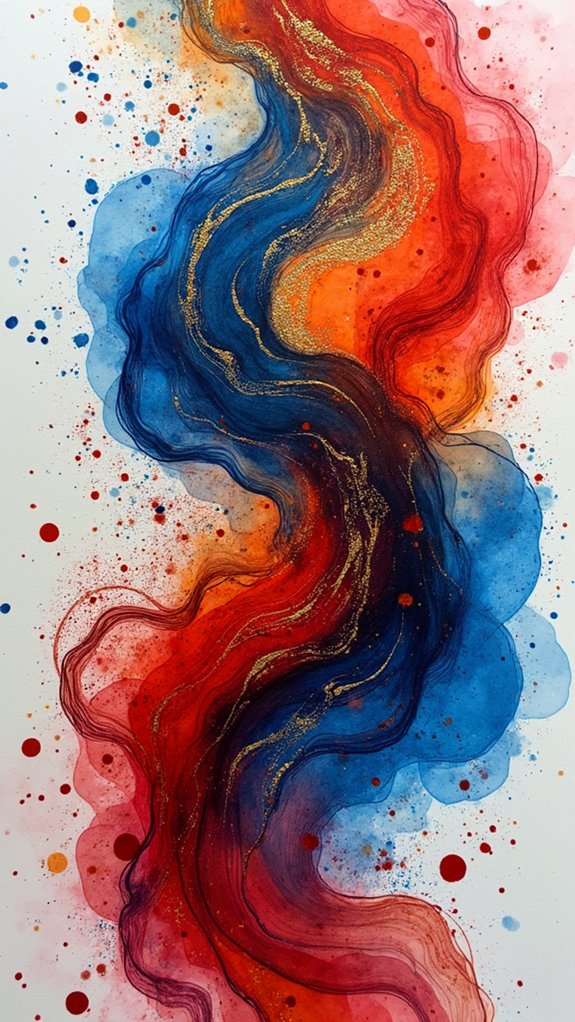
Whether an artist is just starting out or already has a bunch of sketchbooks piled up, diving into abstract exploration and pattern play is like revealing a secret playground for the imagination.
There are no rules here—just freedom to let ideas run wild. Abstract exploration invites artists to break free from drawing “perfect” things and instead, mess around with shapes, colors, and forms in wild, surprising ways.
Pattern play is all about repeating and twisting shapes—think stamping, doodling, layering, or gluing on bits of paper—for totally unique and vibrant compositions.
Using things like textured papers, juicy paints, or even markers, pages come alive with creative expression.
It’s actually fun to let go, make mistakes, and see where those random colors and lines can lead!
Favorite Quotes With Illustrations
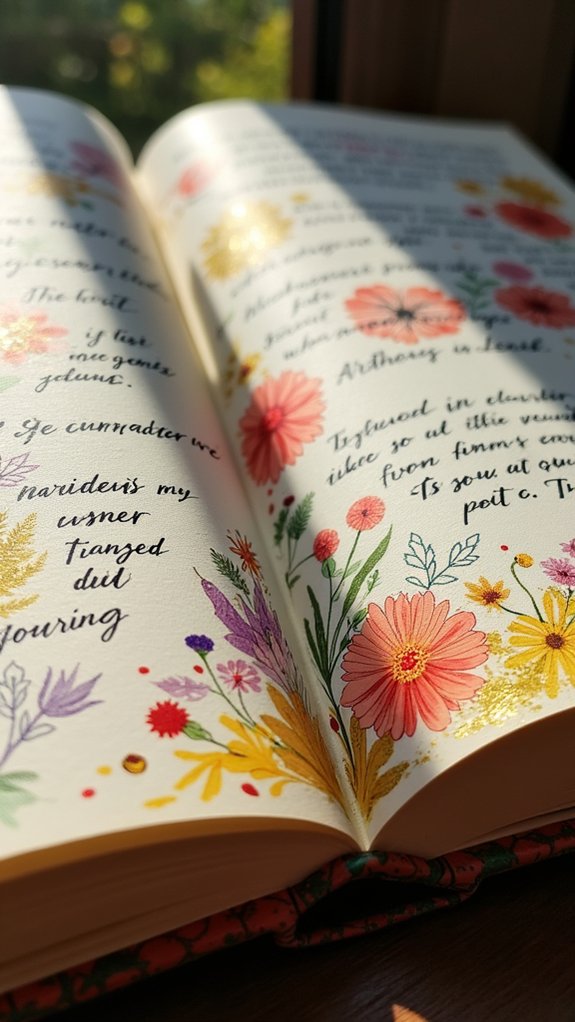
Splatters of color and crazy patterns are just the beginning—sometimes, what really brings a sketchbook page to life is a favorite quote, turned into art.
Illustrating quotes is a way to pour all that love for words and drawing into one super creative inspiration page. Playing with hand-lettering, funky calligraphy, or even bold typographic styles can totally change the mood.
Imagine painting a swirling watercolor sky behind a motivational message, or doodling starry borders around lyrics that hit you right in the feels. With every quote, every swash of color, the sketchbook starts to feel like a reflection of your heart and your head.
Want to level up?
- Capture quotes that move you deeply.
- Mix colors and textures for extra wow.
- Share your illustrated quotes to spread joy!
Emotional Expression Pages
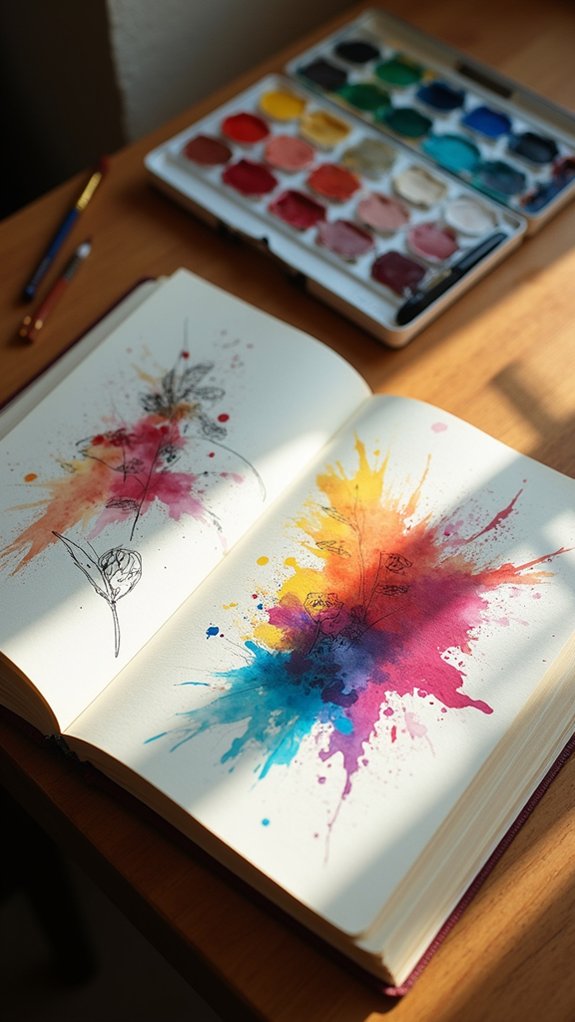
Heartbreak, happiness, excitement, or just a plain old weird day—emotional expression pages are where all those feelings finally get to run wild. In these pages, artists use visuals to spill out whatever’s going on inside, sometimes messy and unfiltered, which honestly makes the whole thing feel more real and packed with authenticity. Maybe a butterfly flutters across the page, hinting at change or a big life moment. Other times, wild layering or splashes of mixed media ramp up the drama and depth. Nostalgia sneaks in, too, with memories doodled or painted, showing how much someone has grown. If you want inspiration, check out the table below! It’s got quick ideas for exploring emotional expression in your sketchbook.
| Emotion | Visual Element |
|---|---|
| Happiness | Bright Colors |
| Sadness | Raindrop Sketches |
| Nostalgia | Faded Photographs |
| Excitement | Swirling Lines |
Creative Scrapbooking With Ephemera
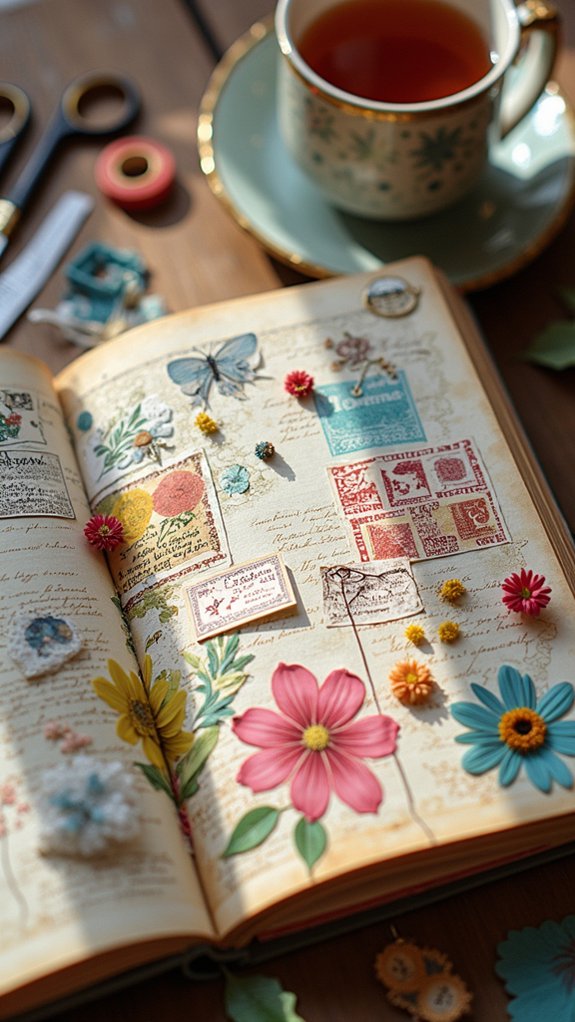
There’s just something magical about turning a sketchbook into a treasure chest full of stories using all sorts of found bits—think ticket stubs from last summer’s concert, a postcard from Grandma, or even a candy wrapper that somehow survived your backpack.
Creative scrapbooking with ephemera brings excitement to every page. Whether it’s using decoupage to layer these treasures, or mixing them with washi tape and stamps, each piece adds texture and a burst of storytelling.
The best part is experimentation—combining different ephemera means every sketchbook spread will surprise you. Each page becomes a tiny museum of memories, packed with visual delight and feelings you don’t want to forget.
- Discover a long-lost photo and instantly relive that day.
- Feel your heart race as you glue down your concert wristband.
- Laugh at an old movie ticket tucked beside a doodle.
Frequently Asked Questions
What Is the Drawing App That Everyone Is Using?
When considering popular drawing apps for digital art tools, many users are turning to Procreate as their preferred creative software option. Its ease of use, robust features, and mobile sketching capabilities make it widely favored among artists.
What Should I Put on the First Page of My Sketchbook?
When deciding what to put on the first page of a sketchbook, one might consider including inspirational quotes, outlining personal goals, adding creative doodles, or experimenting with favorite colors to set a welcoming and motivating tone.
Why Do Artists Keep a Sketchbook?
Artists keep a sketchbook to facilitate artistic expression, enable creative exploration, and support regular practice routines. These books also serve as tools for visual journaling, allowing artists to reflect on personal growth, document ideas, and capture inspiration.
What Should I Draw on My First Page?
When considering what to draw on the first page, one might explore first page inspiration through drawing prompts, personal themes, or creative exercises. This approach encourages artists to experiment, set intentions, and ease pressure on their sketchbook’s beginning.
Conclusion
So, whether someone loves doodling trees, collecting ticket stubs, or mixing colors till the page explodes, these sketchbook page ideas make creativity way more fun. There’s no single “right” way to fill a sketchbook—it’s all about experimenting and letting personality shine. Sure, some pages might get a little wild or messy, but that’s half the excitement! Grab a pen, splash some color, maybe add a quote, and watch the blank pages turn into something totally unique.

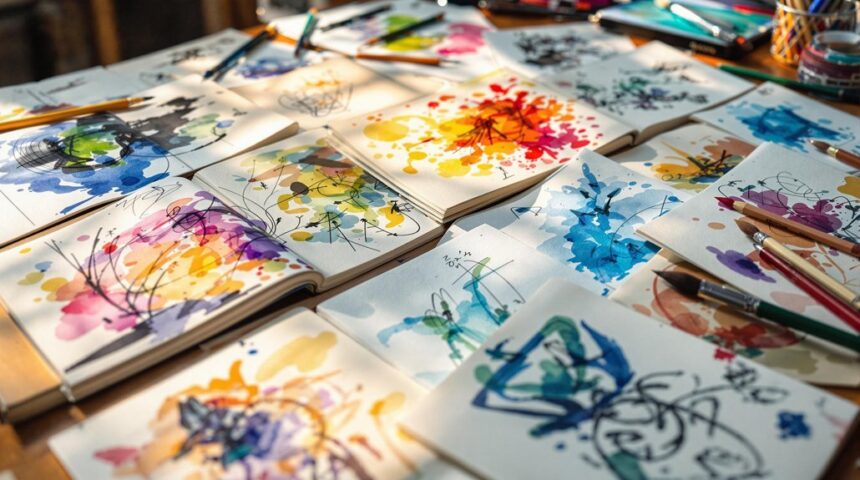
Leave a Reply